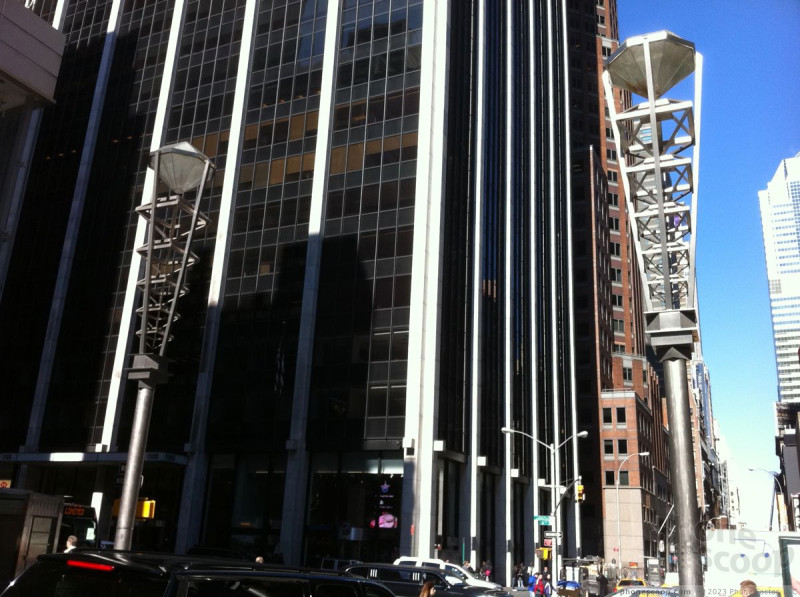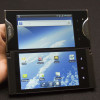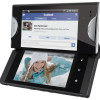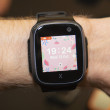Review: Kyocera Echo
Apr 12, 2011, 11:00 PM by Eric M. Zeman
updated Apr 22, 2011, 10:42 AM
Kyocera boldly ventures forth where no smartphone has ventured before with the dual-screened Echo. Kyocera attempts to answer a question that has plagued humankind since the beginning of time.
Form
Is It Your Type?

The Kyocera Echo, with its dual-screen design, boldly goes where no smartphone has gone before. Do you dare follow it? Only the adventurous soul seeking a radically new smartphone experience need apply, as Kyocera sets out to prove if two displays are truly better than one.
Body
The Kyocera Echo is a pretty big departure when it comes to handset design. It has two displays that, when unfolded, join to form one, massive, tablet-esque 4.7-inch display. If that's too much screen action for you to handle, it can also be used with only one of the two 3.5-inch displays visible, or with the displays angled laptop-style. The Echo essentially provides three different physical modes of operation. In order to do this, Kyocera had to make some interesting design choices.
First, the Echo is insanely thick when all closed up. At 17mm/0.68 inches, it is thicker than my laptop. Second, in order to get the screens to fit snugly together with as little bezel between them as possible, the Echo is rectangular to a fault. It's literally shoe-box shaped, and has hard corners and 90-degree angles. Third, it is ugly as sin. It looks more like a prototype from the 90s than anything that's hitting the market in 2011. Everything about its design is industrial and unfriendly.
It really does feel like holding a brick. With its hard angles, sharp edges, thick waistline and hefty weight, I found it uncomfortable to use. Pocket friendly? No way in hell. When put in even a loose front pocket, it can be painful when caught the wrong way (such as when getting into/out of cars). As for overall build quality, the plastics feel cheap, but the fit and finish is decent.
The hinge system is interesting. If you're worried about its strength and dependability, don't. It is tough as nails. Kyocera engineered it for strength. In order to get the Echo open, grab either side (doesn't really matter which) of the top half of the device and pull up. Once you get it up about an inch, the springs take over and snap it into what Sprint refers to as "Simul-Task" mode.
In Simul-Task mode, the Echo positions the two screens at about a 30-degree angle for easier viewing and typing. The assumption is that you'll hold the Echo sideways when in Simul-Task mode.
If you want to put the Echo in tablet mode, simply push the top half down until it is even with the bottom half and then push them together until it snaps into place. It's a loud, clacky process; you'll figure it out by sound. With the Echo in tablet mode, it is a large, pancake-sized slab of technology that has a 4.7-inch display. You can hold in in any orientation you wish; it doesn't really matter. Really what you need to decide is: do you like the black bar - where the two displays meet in the middle - running up and down, or from side to side? For me, side to side was preferable.
Holding the Echo in tablet mode is pretty comfortable. The hinge on the back creates a natural grip point for your fingers, letting you grip it tightly without stretching your hand across its 4.35-inch width. Obviously, it is also much thinner. The weight is balanced, with your thumbs have easy access to the entire display.
As for the rest of the controls, they are all positioned on the left side of the Echo (or the bottom when in Simul-Task mode). There is a 3.5mm headset jack, a hatch covering the microSD card port, the power/lock key, volume toggle, and finally microUSB port. Both the microSD and microUSB ports are easy to get at, and the soft plastic hatches present no obstacle. I don't know about you, but I like the power/like key to be on the top of the device, not on the side, and especially not on the LEFT side of the device. It will take a lot of muscle memory training for me to get used to. It is a bit small, but has great travel and feedback. The volume toggle is also too small, but offers great travel and feedback.
Don't take any of this to mean that I hate the Echo. I don't. I absolutely get it and its use case. I simply feel alienated by the hardware.
The Three S's
Screen
Technically, the Echo has two, separate 3.5-inch displays. When positioned next to one another, they create the illusion of a single, larger display. Individually, these two 3.5-inch panels look about on par with most similar-sized Android handsets. They offer good pixel density, and are bright and colorful. In side by side comparisons, the two displays look exactly the same; you can't tell them apart. I did notice that they wash out a bit when outdoors in sunlight, but many phones suffer the same thing. The Echo, however, was still readable and I didn't have trouble using it as a camera even under bright sunlight.
Signal
Signal performance is all over the map with the Echo. It never consistently held onto Sprint's network. Sitting on my desk, it would show 5 bars, then drop to 2, then go back up to 4, then dwindle down to 0. In my basement, it alternately dropped the network entirely, and then displayed full signal strength. The Echo dropped a number of calls, and several required redialing before they could go through. Data connections were also spotty. Sometimes it connected right away, other times it stalled badly. Signal performance was quite poor on a trip into Manhattan. For example, the Echo took a long time to reconnect to the network after emerging from subway tunnels.
Sound
Call quality with the Echo was spotty. Earpiece volume was plenty loud, but calls suffered from a lot of scratchy static. I had the sound drop out entirely a number of times, and the clarity was simply not good. Those with whom I spoke said that I sounded distant. Ringers, alerts and other notifications are plenty loud, though. The speakerphone offers plenty of volume, but that volume does little more than amplify the awful quality of calls. The vibrate alert is crazy strong.
Battery
The Kyocera Echo ships with a spare battery and a battery charger. That should serve as a warning right there. The included battery is only 1370mAh, which seems anemic for a device with two 3.5-inch displays. I was able to drain the Echo's battery from a full charge to 100% dead in just three hours when using both screens. If you ignore the second screen completely and stick with just one, you'll do much better. I got nearly a full day out of it (from 7AM to 9PM). Mixed used of both screens — which is what I expect will be the "normal" use case — killed off the battery in about 8 hours. That's just not good enough, but tells us why the Echo comes with an extra battery. My advice? Make sure the spare is always charged.
Basics
Menus
The Echo uses a near-stock version of Android 2.2, with the notable addition of several features that specifically harness the two screens. Rather than look at the Android 2.2-specific stuff, we're going to focus on what makes the Echo unique with respect to its menu system.
Sprint claims the Echo works in four distinct modes: Single-Screen, Simul-Task, Optimized, and Tablet.
In Single Screen mode, the Echo behaves like any other bar-style Android handset; nothing new or fancy to report here.
In Simul-Task mode, the Echo supports two full applications running separately, one on each display. There are seven core applications that can work in this mode, including messaging, email, the browser, phone, photo gallery, contacts, and VueQue (more on that one later). This functionality is absolutely killer and is flat-out the best way to multitask on a phone.
Why? You can browse the web on one screen and watch a video on the other; you can compose an email on one screen and a text message on the other; you can scan through your photos and make a phone call on the other. That's real power. My favorite combination was browsing in one window with email running in the other. It truly works as well in reality as it does in theory. Awesome stuff.
In Optimized mode, the Echo runs a single application that has been significantly upgraded to work with the Echo's dual-screen set up. There are a limited number of apps that support this mode at launch, though Kyocera is offering special software tools that third-party developers need to optimize their apps for the Echo.
Here's the crux of how Optimized Mode works: Let's say you're composing an email. The email text will fill the top screen, and a software QWERTY keyboard will fill the bottom screen. Or, let's say you're watching YouTube videos. You can watch a video in one display, and scan through YouTube on the other screen for more videos to watch. You can also do things such as run two separate browser tabs that are both visible at the same time. Given the possibilities that two screens presents, I really can't wait to see what developers do to optimize their apps for this dual-screen experience. The potential is unlimited.
Tablet mode is how most apps will act on the Echo. They'll simply stretch across the full 4.7-inch display without any specific new features that take advantage of what the Echo offers. As long as you don't mind the black bar running down the middle of the app, it offers a huge amount of screen space. It's an ideal way to look at certain apps, such as Google Maps, your photos, large web pages, and so on. Having such a large amount of real estate is really cool when you want to be able to see the bigger picture.
What's it like to transition between all these modes? Well, Single Screen mode is obvious. Simply open it up and it automatically converts to Tablet mode (whether the Echo is flat or not). As mentioned, only specific apps are customized for Optimized and Simul-Task modes. The Simul-Task apps can be launched by tapping both screens at the same time. This brings up the list of apps that can function in Simul-Task. Select the ones you want and bingo, there you go.
Apart from these different modes of operation, the Echo's base Android 2.2 software will be familiar to anyone who's used an Android handset before.
In terms of system performance, I experienced several hard crashes that required a battery pull, and the system stuttered a few times, but it wasn't terrible. Most of the time, it performed quickly and smoothly.
Calls/Contacts
The Echo uses the stock Android phone and contact applications, though they can be used a little bit more effectively with the dual-screen set up.
For example, you can open up the Echo laptop-style and load the SMS app on the top screen and the phone app on the lower screen. Dial a number (or sort through your contact list via the standard Android tabs), and away you go on a call. While on that call, you can read through the messages in your inbox and do things such as load images from MMS messages without losing access to the phone app's features. This is ideal for situations when you need to access information from your inbox and read it back to someone on the phone.
Thankfully, Kyocera was smart and picked the most essential applications for Simul-Task and Optimized modes, including the phone, email, contacts, and messaging. Kyocera is obviously hoping that business users notice this and choose the Echo over other, less multitask-y devices.
The core tool set remains the same, you can simply do more with them.
Messaging
The messaging applications on the Echo are essentially no different from any other Android 2.2 handset. The stock email, Gmail, SMS/MMS, and Google Talk (IM) apps are all present and accounted for. As already noted, the Echo offers a richer experience with some of these thanks to its different modes of operation.
The email app works great in both Simul-Task and Optimized modes. The best feature in Optimized mode is having access to a software QWERTY keyboard (with Swype, no less!) on one display and the email you are typing on the other. The larger software QWERTY makes a world of difference when it comes to improving the speed and accuracy of typing on the glass.
Need to grab an image from an SMS someone sent you and stick it in that email? No problem. Tap the two displays at the same time, and the Simul-Task screen pops up, letting you open the SMS app. You can copy and paste directly from one to the other. That's really helpful.
The SMS/MMS app provides the same features on the Echo, such as threaded conversations, and in-line media support. Google Talk is also unchanged. Using Google Talk to IM and the SMS app for texts at the same time is neat.
On the social networking front, neither Twitter nor Facebook is pre-installed. You'll have to snag them from the Android Market in order to use them. There is, however, a custom social networking app called Jibe that's on board. I found this to be an annoying substitute. Why? You have to sign up for a Jibe account before you even know what functionality it provides, and it is yet another app that I have to grant access to my social networking feeds.
Once you log in, you'll find that it is (yet another) social networking tool that pulls together all your apps/services into one spot. True, it is a more robust than some of the other apps out there (better support for Twitter DMs and Facebook messages, for example), but I still prefer the stand-alone Twitter and Facebook apps. I am sure some of you will like Jibe, but it didn't jive well with me.
Foursquare isn't preloaded, but Google's Latitude is.
Of all the apps and services that may or may not be customized for the Echo's dual-screen set up, I truly hope that Facebook, Twitter, Foursquare and others are on the short list.
Extras
Media
Music
The Echo uses the stock Android music player application. The stock media player is bare bones, but it does get the job done. You can sort through your playlists, artists, albums and songs easily enough, and album art comes through properly when tagged to the music. The media player can be sent to the background while you do other things such as browse the web or check Twitter.
I suppose I am disappointed that the Echo doesn't do anything fancy-schmancy with the music app, but that's just me.
The device also includes Sprint Radio, and of course can access any music apps from the Android Market.
Video
The Echo has a new video application on board called VueQue. It integrates with Google's YouTube service and lets users watch a video on one screen while they surf and queue up another in the screen below.
From the video searching tool, you simply grab a video and drag it over to your queue. The queue supports at least 10 videos at a time, and they'll automatically play as you continue watching. It's definitely a neat upgrade to the basic YouTube experience.
The Echo also offers the normal YouTube application, Sprint Football Live, NASCAR, and Sprint TV & Movies. These apps all behave exactly as they do on other handsets.
Camera
Camera
The Echo has a 5-megapixel camera with auto-focus and flash. The camera opens up reasonably fast and the viewfinder offers plenty of room for composing shots.
To the far right, there is a stock-looking set of software toggles for jumping to the video camera, the gallery, and a software shutter button. Next to this set of tools, there are five icons sitting in the viewfinder area. Press any of the icons, and a drop-down menu appears for adjusting the cameras settings. It's easy and you don't have to leave the viewfinder to make any of the adjustments.
Press the shutter button and the Echo takes a second to focus and then shoot the image. The review screen lasts about one second, and then the camera reverts to the viewfinder.
If you open the Echo up and attempt to use the camera with the device in tablet mode, you'll notice that all the tools located on the far right side of the viewfinder are relocated to the bottom screen. This makes them bigger and easier to work with, though holding the Echo in tablet mode for shooting pictures feels ridiculous. Also, in tablet mode, it is practically impossible to avoid covering the camera with your finger (or at least smearing finger oils all over it).
Gallery
The gallery is the stock Android option. Photo albums float in stacks in the main gallery view, and you can sift through them in the chronological timeline in which they are arranged. It has a neat 3D look and feel to it. When opened in tablet mode, the image fills most of the 4.7-inch space, with some navigation tools and controls sprinkled across the bottom on the screen.
As far as editing goes, the options are somewhat limited. The Echo offers crop, rotate and "edit." Opening the "edit" tool actually does nothing of the sort, however. Instead, it lets you write on, stamp on, draw on, or otherwise mark up your photo. There's no "editing" in the traditional sense if you're expecting the ability to adjust brightness, color tone, contrast, etc. (with the exception of rotate and crop).
Photos/Video
Photos
With a 5-megapixel shooter with both a flash and auto-focus, I expected to achieve decent results with the Echo, and I wasn't disappointed. While only a few of the images I captured were exceptional, many of them were very good.
Focus was mostly sharp, though I noticed a bit of noise here and there. Color accuracy and white balance were on track most of the time. About the biggest problem I saw was blown-out detail in over-exposed shots. The Echo's images are definitely Facebook-worthy, though print-worthy shots will be a rarity.
Video
Video, whether shot in YouTube quality or high quality, is pretty good. I saw a bit more noise in the lower quality setting, but focus, color accuracy and white balance were all even.
Browse/Customize
Browser
The Echo uses the stock Android 2.2 browser. The browser software and controls are unchanged when compared to other Android 2.2 devices, though the dual-screen set up goes a long way to making the overall experience a lot more fun.
For example, being able to see two live web sites at a time, rather than being forced to use clunky software tools to jump between open tabs. Being able to use the browser and email, SMS, phone app at the same time is also insanely useful.
Browsing speeds were wildly inconsistent on Sprint's 3G network. Sometimes web sites loaded in the blink of an eye, and other times they took nearly a minute to arrive. The Echo's browser performed flawlessly on Wi-Fi, though.
Customize
The Echo allows for about the same level of customization that other Android devices to, although its expanded modes of operation may make it feel like the Echo is far more customizable. When you get right down to it, the wallpapers, ringtones, etc., can all be set to the exact same options as on any Android device.
Extras
Apps
Most applications from the Android Market will work on the Echo. When used in Single Screen mode, it behaves as any other Android device, so you're covered in that respect. As mentioned earlier, there are only a few apps that support the Simul-Task and Optimized modes. They are already on board, and I didn't see any more in the "Echo Top App" tool on the Echo. Presumably more will become available over time. Any Android app will work in the tablet mode, which essentially just stretches everything out to fill the screen.
Bluetooth
The Echo can connect with mono and stereo Bluetooth headsets with no problems. I didn't encounter any issues when pairing different devices, though sound quality through both mono and stereo headsets was miserable. The Echo can also be used to push pictures (and other files) between devices, such as PCs or other phones.
GPS
The Echo offers two options for directions: Google Maps and TeleNav. Both are free. I enjoy Google Maps and think it does a great job of providing directions. TeleNav is a solid alternative, though, and Sprint doesn't charge for its use. Both will get you from here to there with no problems. The TeleNav app also offers voice commands, though they only worked about half of the time.
Wrap-Up
The Kyocera Echo is certainly one of most intriguing handsets to come along in recent memory. Do two screens make for a better handset? That really depends on your point of view.
First, the Kyocera fails the basics in my book. The two screens necessitate the need for two batteries. Swapping out batteries day in and day out, and remembering to charge them both, will be painful over the long haul from my perspective. Even with both batteries, I was unable to get through an entire day of what I consider to be average use for this device. Let's not forget how inconsistently the Echo connects to Sprint's network and how cruddy call quality is.
Second, the industrial design will surely turn people off. There's absolutely nothing appealing about the hardware in terms of looks or how it feels in the hand or the pocket. While we need to cut Kyocera some slack because the form factor played a large role in the design and engineering of the Echo, I wish it were much more refined.
However, the ability to use different apps on the two different screens is an eye-opening step forward. The Echo is the first handset that can honestly and truly multitask, as far as I am concerned. The four modes of operation offer a wide range of ways to use the Echo that will certainly appeal to some folks out there. As more applications are developed to support the Optimized and Simul-Task modes, the Echo will only grow in is multitasking powers.

Comments
(continues)
I've been saying this all along...
"The Echo is the first handset that can honestly and truly multitask, as far as I am concerned"
And it's true.
No matter how hard you bash Windows phone or iOS, NO PHONE truly multi-tasks unless you can actually USE two apps at the same time like on a computer.
It would be fun to see a better manufacturer produce a phone like this... HTC???
Kyocera might not be at the height of fashion, but they have usually built solid devices (7135, anyone??).































 Hands-On: Kyocera Echo
Hands-On: Kyocera Echo
 Kyocera Echo Sports Two Displays, Hinged Design
Kyocera Echo Sports Two Displays, Hinged Design
 Kyocera Echo
Kyocera Echo



